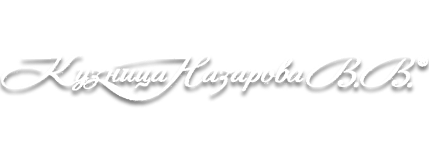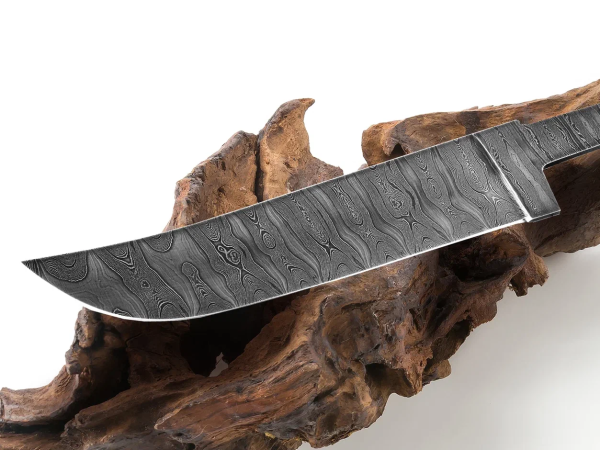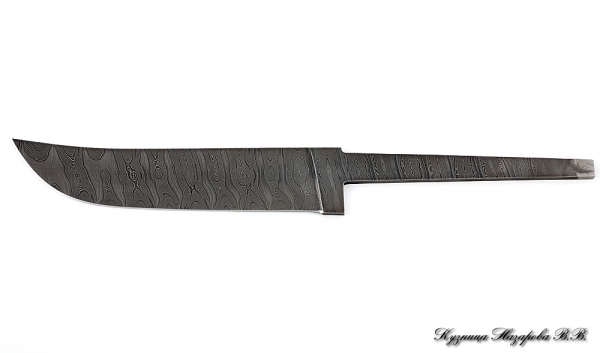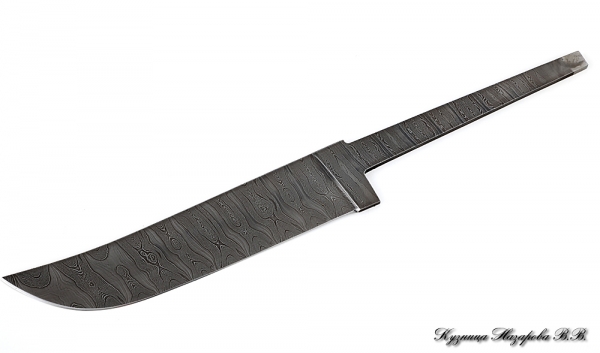Blade Uzbek Damascus
Blade Uzbek Damascus
- Форма клинкаTrailing point
- Blade steel tipeDamascus
- Lengtn blade (os)150 mm
- Толщина клинка3.5 mm
- Witdth blade (os)36 mm
- Shank length125
- Hardness (HRC)62
Blade: The knife is made of high-quality Damascus steel with a hardness of 62 HRC. Damascus is known for its unique structure and combination of strength with high wear resistance. This hardness ensures long-term retention of sharpness, making the knife ideal for long work sessions without the need for frequent sharpening.
Geometry and shape: The length of the blade is 150 mm with a width of 36 mm and a thickness of 3.5 mm, which gives the product a universal balance — massive enough for serious tasks, but not devoid of maneuverability. The shape of the blade — the trailing point, historically characteristic of Uzbek knives, provides outstanding cutting ability, the elongated rise of the butt line gives excellent control during precise cutting.
Hand hold: The material of the handle has not been specified, but the design assumes a traditional oriental format, focused on confident grip with both bare hands and gloves, which is especially important during long-term work and when changing grips quickly.
Resistance to moisture and corrosion: Damascus steel requires careful maintenance — despite its excellent wear resistance and strength, it is more susceptible to moisture than modern corrosion-resistant alloys. It is recommended to wipe the blade dry after use and periodically treat it with protective oil, especially when stored in a humid environment.
Wear resistance and durability: The hardness of 62 HRC combined with the layering of Damascus guarantees a long-term service life of the cutting edge and resistance to chipping when used correctly. However, excessive stress on the fracture (for example, an attempt to break bones or open hard objects) can lead to damage due to high hardness.
Care and sharpening: Damascus is relatively easy to fix on ceramic or water stones, however, it requires care to preserve the pattern and factory geometry. Keeping it sharp doesn't take much time with timely edits.
Optimal usage scenarios: The classic Uzbek shape and characteristics of the knife make it an excellent tool in the kitchen for filigree cutting of meat, chopping vegetables, working with herbs and fruits, as well as for serving dishes. Thanks to its sharp tip and smooth cutting edge line, the knife does an excellent job with precise cuts and artistic slicing. It is suitable for collectors who appreciate traditional manufacturing techniques and aesthetics of oriental weapons.
What is not suitable for: We do not recommend using the knife for heavy woodwork, opening canned food, chopping bones, or as a knife for survival in extreme conditions. It is not designed for heavy loads and work on hard materials.
The Uzbek knife made of Damascus steel is not only a working tool, but also a part of cultural heritage. Each piece is the result of painstaking handwork, and the textured surface of the blade reflects the individuality and talent of the craftsman. The Damascus steel manufacturing technique gives each knife a unique pattern and sets it apart from its factory counterparts. It is these knives that are appreciated by collectors and gourmets who seek to emphasize their individuality.
To maintain the perfect condition of the blade, it is recommended to wipe it thoroughly after each use and store it in a dry place. Lubricate the blade with neutral oil periodically to prevent corrosion. For sharpening, use only high-quality abrasive stones to preserve the original geometry of the cutting edge and the unique Damascus pattern.
This knife is ideal for connoisseurs of Oriental cuisine, professional and home cooks, collectors and those who are looking for a unique and aesthetically expressive handmade tool with a rich history. It performs best in tasks related to the precise cutting and processing of products, as well as in the role of a striking collector's item. It is not recommended for heavy and rough work, which is important to consider when choosing. The main advantage of the knife is its exclusivity, aesthetics, reverence and historical authenticity, provided careful treatment and proper care.
Detailed analysis of the properties and features of the knife
Scope of application: tasks and limitations
Unique and distinctive features
Recommendations for care and operation
Conclusion and recommendations
В видеоматериале представлено похожее изделие. Может отличаться по некоторым параметрам.
В видеоматериале представлено похожее изделие. Может отличаться по некоторым параметрам.










